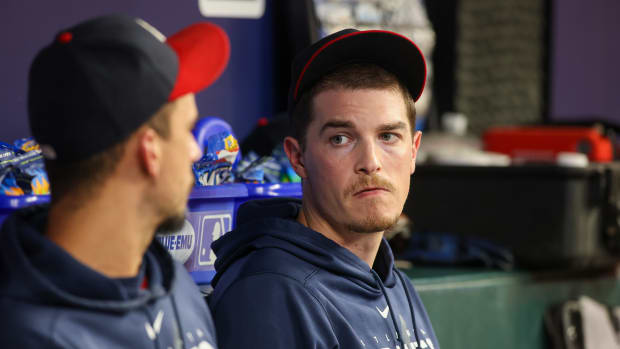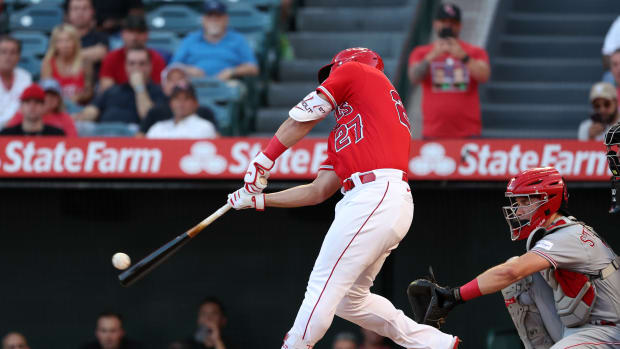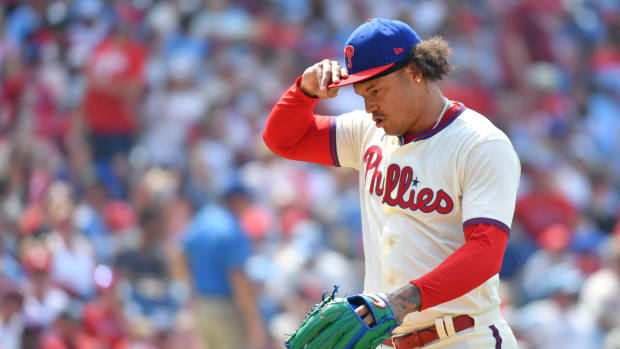One of the Most Bizarre Calls in Baseball Happened to the Phillies on Friday
The Official Baseball Rules, as put together by Major League Baseball, are 187 pages long. The document is wordy, it is complicated, and, of course, it is lengthy. Thus, unsurprisingly, there will always be rules with which even the most ardent of baseball fans are unfamiliar.
One such rule came into play during the Philadelphia Phillies game on Friday afternoon.
Things started out normally enough. It was the bottom of the seventh, and Zach Eflin was on the mound. Victor Robles was at the plate, and Luis García was at second base. Eflin threw a ball, a called strike, and then another ball.
On the fourth pitch of the at-bat, Robles finally swung. And while he missed the ball, he did make contact with J.T. Realmuto backside on his backswing.
Realmuto was standing up to catch García leading off of second, and unaffected by Robles' bat, he threw a perfect strike to Jean Segura. García, therefore, took off for third, and Segura tossed the ball over to Alec Bohm who tagged him for the final out of the inning.
But not so fast. The umpires kept both teams on the field and sent García back to second base. It was as if the play we all just witnessed hadn't happened at all. What was going on?
The simplest explanation was catcher interference, especially because it was the Phillies who were penalized. However, if it really were catcher interference, Robles would have been awarded first base. The rules are quite clear about that one. So no, it wasn't catcher interference. Technically, it wasn't interference at all.
Instead, the umpires determined that Robles had unintentionally hit Realmuto with his follow-through. In such a case, the rulebook says, "it shall be called a strike only (not interference). The ball will be dead, however, and no runner shall advance on the play."
There we go, that accurately explains the call on the field. But wait a minute, what's this?
If the ball were truly dead, it wouldn't have mattered if Segura had tagged García or not. So while the rulebook is a little fuzzy on this one, it does seem like there is an exception to the dead ball rule.
According to some interpretations, "If this infraction [batter unintentionally hits the catcher on his backswing] should occur in a situation where the catcher’s initial throw directly retires a runner despite the infraction, the play stands the same as if no violation had occurred."
The rulebook does not clear and directly explain this. However, in the paragraph directly preceding the rule that covers the situation at hand, the rulebook states, "If, however, the catcher makes a play and the runner attempting to advance is put out, it is to be assumed there was no actual interference and that runner is out."
Thus, the umpiring crew seem to have decided that the same rule applies in the case of a batter hitting the catcher on his follow-through.
So, had Segura been able to tag out the runner without tossing to Bohm, García would have been out, because the umpires could have claimed Realmuto's throw "directly retired the runner," and therefore it wouldn't have mattered that Robles hit him on the back. However, because a second throw was required to tag out García, the ball was ruled dead and the runner was not out.
It would have taken a lot of decision-making and interpretation for the umpires to reach that conclusion –was Robles' follow-through unintentional? Could Realmuto have directly retired the runner with his throw? Was the ball dead? – but ultimately, that explains the confusing events that took place on the field. Phew. Glad that's done with.
Oh, what's that? It's not over you say?
Nope. Not even close.
When play resumed, home plate umpire Marvin Hudson correctly announced the count as 2-2, two balls and two strikes. But after Eflin threw the next two pitches for balls, Hudson re-announced the count as 3-2. It was as if he thought he was wrong when he first announced the count and so he was correcting for his earlier mistake – except there had been no mistake. Eflin had thrown four balls in the plate appearance, and Robles should have been issued a walk.
Instead, Eflin was gifted another chance, and this time he delivered a strike to set down Robles and end the inning. While it will go down as a strikeout in the box score, those of us watching will know it should have been a walk.
Two equally bizarre calls happened in the same at-bat, and to make things even stranger, they were completely separate decisions. Sure, the confusion caused by the first call is what led to the other, but nevertheless, two the calls were not directly connected. That makes the whole situation extra weird.
To sum it all up, one of the most bizarre calls in baseball impacted the Phillies on Friday, and somehow it wasn't even the strangest call of the at-bat.
The first call was strange but seemingly correct. The second was strange because it was just plain wrong. And you might never see either one called again.
More From SI's Inside The Phillies:
- Phillies Star Bryce Harper Doesn't Hold Back on Thoughts About Joe Girardi
- How Mike Trout Will Join the Phillies
- Could Bryce Harper's Favorite MLB Player Join the Philadelphia Phillies Next Season?
- Why You Should Root for the Philadelphia Phillies to Lose a Few Games
- Phillies Release 2023 Regular Season Schedule
- Have the Philadelphia Phillies Found Their Centerfielder of the Future?
- Could The Phillies Soon Be Playing in Wawa Park?
- How did Philadelphia end up with Citizens Bank Park?
- How the Phillie Phanatic Came to be America's Favorite Sports Mascot
- Picking the Phillies' All-Time Single Season Lineup
Make sure to follow Inside the Phillies on Substack and Twitter!





